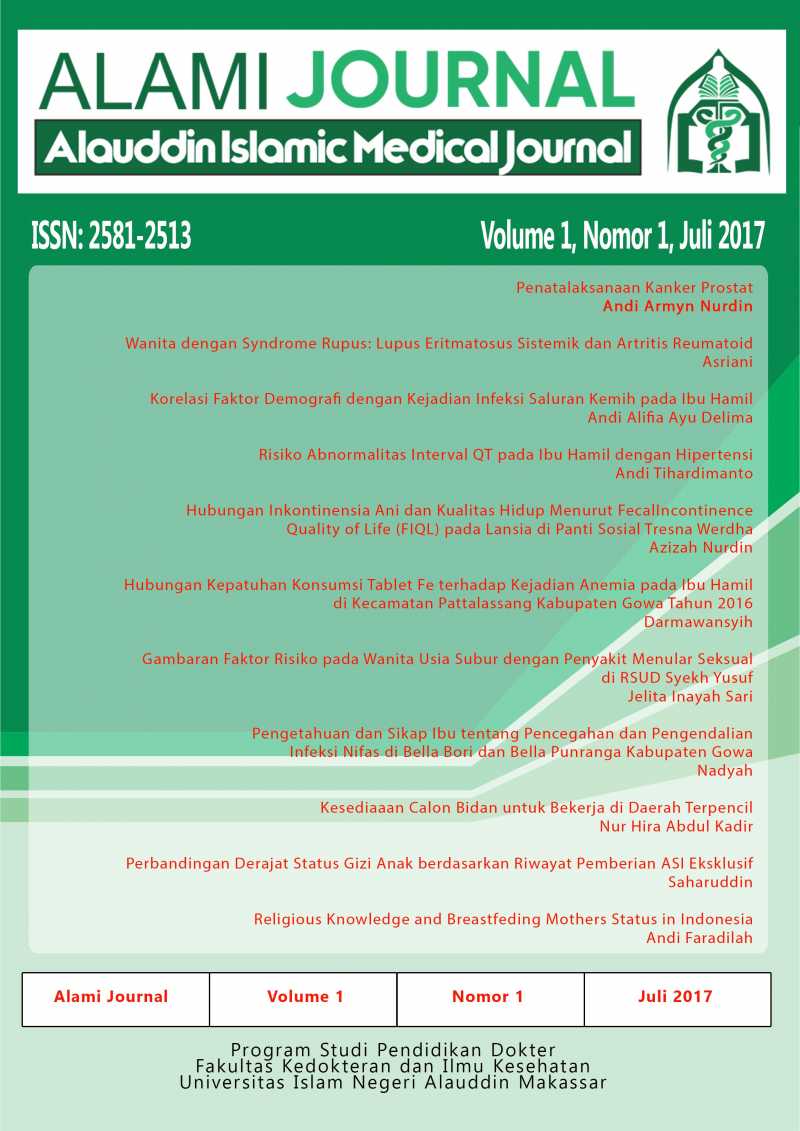HUBUNGAN INKONTINENSIA ANI DAN KUALITAS HIDUP MENURUT FECAL INCONTINENCE QUALITY OF LIFE (FIQL) PADA LANSIA DI PANTI SOSIAL TRESNA WERDHA
Abstract
Inkontinensia ani merupakan kondisi kesehatan yang secara fisik dan psikososial secara negatif mempengaruhi kualitas hidup seseorang. Penelitian ini bertujuan untuk mengetahuihubungan inkontinensia ani dengan kualitas hidup pada lansia. Penelitian ini dilaksanakan dipanti sosial Tresna Werdha 1 Oktober 2016 sampai 31 Desember 2016. Metode yang digunakan adalah desain cross-sectionaldengan sampel berjumlah 95 orang. Instrumen yang digunakan untuk menilai inkontinensia ani dan kualitas hidupnya adalah self-adminnistered questionnaire terdiri dari fecal incontinence severity index dan fecal incontinence quality of life. Data diolah dengan uji chi-square dan tingkat signifikansi p<0,05. Hasil penelitian menunjukkan bahwa karakteristik subjek penelitian mayoritas berusia lebih dari 75 tahun yakni 49 orang (51%), berpendidikan rendah85 orang (89,5%), memiliki indeks massa tubuh yang normal yakni 90 orang (95,7%) serta mengalami inkontinensia ani 9 orang (14,7%). Berdasarkan analisis statistik, individu dengan inkontinensia ani cenderung memiliki kualitas hidup yang rendah dibandingkan dengan tanpa inkontinensia ani dengan nilai p<0.05. Oleh karena itu, deteksi dini adanya inkontinensia ani sangat perlu untuk disosialisasikan dikalangan petugas kesehatan untuk mencegah menjadi lebih berat yang akan menurunkan kualitas hidup.
References
Fritel X, R. V. (2007). Mode of Delivery and fecal incontinence at midlife : a Study of 2640 women in the Gazel cohort. Obstet Gynecol, 31-8.
Trowbridge, E. (2014). Updates on the treatment of the fecal incontinence. Virginia: ACG/VGS/ODSGNA Regional Postgraduate Course, Female Pelvic Medicine and Reconstructive Surgery.
Whitehead WE, B. L. (2009). Fecal incontinence in U.S. adults : Epidemiology and Risk Factors. Gastroenterology, 137 : 512-517.Baxter NN, R. D. (2003). Measuring fecal incontinence. In Diseases of The Colon and Rectum (pp. 1591-2). Minnesota.
Chiarelli P, M. B. (2003). Fecal incontinence after high risk delivery. Obstet Gynecol.
Suyasa IGPD, P. P. (2011). Prevalence of fecal incontinence in community dwelling older people in Indonesia. National Conference on Incontinence . Melbourne : Victoria.
Rush. (2013). Fecal Incontinence. Rush University Medical Centre, 1-3.
Macmillan AK, M. A. (2007). The Prevalence of Fecal Incontinence in Community-dwelling Adults : A systematic review of the literature. Dis Colon Rectum, 4 : 1341- 1349.
Laine K, S. F. (2013). Prevalence and Risk Indicators for Anal Incontinence. Hindawi Publishing Corporation, ISRN Obstetrics and Gynecology, 1-8 .
Moore. (2012). FecalL incontinence : New Treatment Options. Sinai: Colorectal cancer Centre Cedars-Sinai Medical Center.
Baxter NN, R. D. (2003). Measuring fecal incontinence. In Diseases of The Colon and Rectum (pp. 1591-2). Minnesota
Selcuk S, Cam C, Asoglu MR. The effect of concealed concomitant anal incontinence symptoms in patients with urinary incontinence on their quality of life. Int Urogynecol J. 2012;23(12):1781-1784
Kamal, J. (2012). Rule of Rectal Manometry in Late Management of Fecal Incontinence in Patients Treated By Posterior. Life Science Journal, (9), 4.
Costilla VC, Foxx-Orenstein AE, Crowell. Office-based management of fecal incontinence. Gastroenterol Hepatol (NY).2013: 9(7);423-433
Once an article was published in the journal, the author(s) are: granted to the journal right licensed under Creative Commons License Attribution that allows others to share the work with an acknowledgement of the work's authorship. permitted to publish their work online in third parties as it can lead wider dissemination of the work. continue to be the copyright owner and allow the journal to publish the article with the CC BY-NC-SA license receiving a DOI (Digital Object Identifier) of the work.


